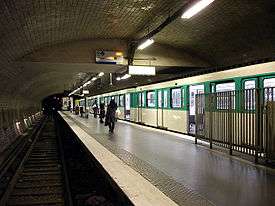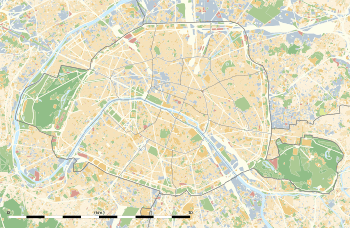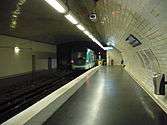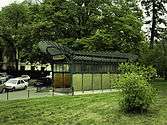Porte Dauphine (Paris Métro)
| Paris Métro station | |||||||||||
 | |||||||||||
| Other names | Maréchal de Lattre de Tassigny | ||||||||||
| Location |
16th arrondissement of Paris Île-de-France France | ||||||||||
| Coordinates | 48°52′17″N 2°16′36″E / 48.87139°N 2.27667°ECoordinates: 48°52′17″N 2°16′36″E / 48.87139°N 2.27667°E | ||||||||||
| Owned by | RATP | ||||||||||
| Operated by | RATP | ||||||||||
| Other information | |||||||||||
| Fare zone | 1 | ||||||||||
| History | |||||||||||
| Opened | 12 December 1900 | ||||||||||
| Services | |||||||||||
| |||||||||||
| Location | |||||||||||
 Porte Dauphine Location within Paris | |||||||||||
Porte Dauphine (Maréchal de Lattre de Tassigny) is a station of the Paris Métro. It is the western terminus of Line 2. Nearby, one can transfer to the RER C at Avenue Foch station (with no direct transfer). Paris Dauphine University is nearby.
Architecture
The station contains one of the three remaining "dragonfly" roofed Métro entrances by Hector Guimard (1867–1942), the Art Nouveau architect who was originally commissioned by the Compagnie du Métropolitain de Paris (CMP) in 1899 to design the entrances for the Métro stations. It is the only roofed entrance that is original, not reconstructed, and on its original site. It was restored in 1999.[1]:43
Porte Dauphine's train hall also features the last complete set of the Métro's original cream-colored tilework. It dates from 1900, shortly before a decision was taken to adopt the Métro's now-ubiquitous white bevelled tilework.[2]:149
History
The Porte Dauphine station was inaugurated on 13 December 1900. At the time, Line 2 had only been completed as far as Charles de Gaulle – Étoile. It now runs from Porte Dauphine around the northern part of Paris, through Montmartre, around to its eastern terminus at the Place de la Nation. It is named after Porte Dauphine, a gate in the 19th-century Thiers wall of Paris. Its subtititle honours Maréchal de Lattre de Tassigny.[3]
Station layout
| Street Level |
| B1 | Mezzanine for platform connection |
| Westbound (drop-off) platform | Side platform, doors will open on the right | |
| Platform 1 | ← | |
| Platform 3 | | |
| Eastbound platform | Platform 4 | |
| Island platform, doors will open on the left for platform 2, right for platform 4 | ||
| Platform 2 | | |
- Note: The station is on a loop, so the westbound/drop-off and eastbound platforms are slightly offset.
Gallery
 "Dragonfly" Art Nouveau entrance designed by Hector Guimard
"Dragonfly" Art Nouveau entrance designed by Hector Guimard MF 2000 rolling stock arriving at Porte Dauphine
MF 2000 rolling stock arriving at Porte Dauphine Porte Dauphine station, designed by Hector Guimard
Porte Dauphine station, designed by Hector Guimard Porte Dauphine station, designed by Hector Guimard
Porte Dauphine station, designed by Hector Guimard
See also
| Wikimedia Commons has media related to Porte Dauphine (Paris Metro). |